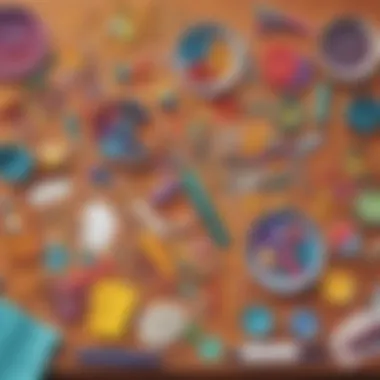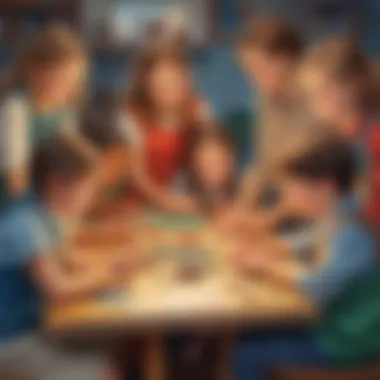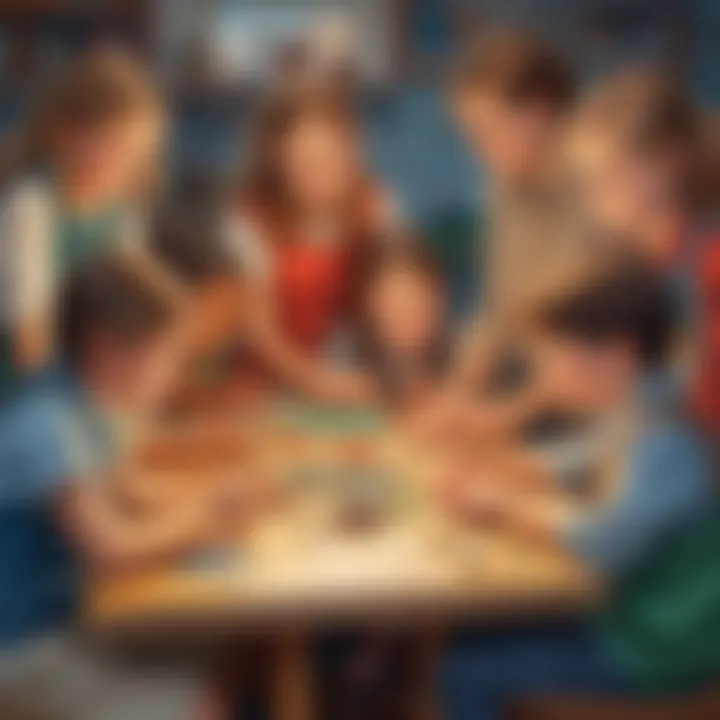Crafting Connections: Team Bonding Activities


Intro
In the context of elementary education, fostering bonds among children is essential. Team bonding through craft activities provides a unique opportunity to strengthen connections and enhance communication among young learners. Engaging in creative projects allows children to collaborate, share ideas, and explore their talents. This article will delve into several aspects of team bonding crafts, focusing on craft ideas, step-by-step guides, and the educational value of these activities.
Creative Activities
Craft activities serve as an excellent medium for developing teamwork skills. They are engaging, tactile, and can be easily tailored to fit various themes and goals.
Craft Ideas
Here are some craft activities that children can replicate easily:
- Friendship Bracelets: Using beads and strings, students can make bracelets that symbolize their friendships.
- Team Mural: A large mural where each child contributes a section allows for artistic expression and a sense of ownership.
- DIY Terrariums: Kids can create mini ecosystems in jars, learning about nature while working together in groups.
Step-by-Step Guides
Providing clear instructions is crucial for successful execution. Here’s an outline for making friendship bracelets:
- Gather Materials: Ensure each child has colorful beads, strings, and scissors.
- Cut the String: Each child cuts a length of string approximately 24 inches long.
- Thread Beads: Children can select beads freely and thread them in patterns they like.
- Knot the Ends: Once made, knot the ends to secure the beads in place.
- Exchange Bracelets: When completed, children exchange bracelets to symbolize their teamwork and friendship.
Educational Value
Participating in craft activities carries educational benefits. Children learn to cooperate, communicate, and express themselves creatively. These projects often encourage problem-solving skills, as kids may face challenges requiring them to think critically together. Additionally, crafts can enhance fine motor skills as children handle various materials.
"Craft activities are not just about creating art; they foster deeper social connections among participants."
This engagement with peers is pivotal in building a classroom environment rooted in respect and support.
Finale
Incorporating crafts into the learning experience offers a myriad of advantages. As educators and facilitators explore team bonding activities, they are not only enriching their students' lives but also nurturing a lasting culture of collaboration and creativity. Every craft project is an opportunity to learn and grow, making them invaluable in an elementary education context.
Understanding Team Bonding
In today's educational environment, understanding team bonding is vital for fostering a collaborative atmosphere among students. Team bonding crafts serve as a fundamental tool for enhancing interpersonal skills and building lasting relationships among elementary school children. The article explores the significance of these activities in promoting teamwork, creativity, and mutual respect, all of which contribute to a more effective learning environment.
The Importance of Teamwork
Teamwork is essential in any group setting. It teaches children how to work together towards a common goal. The act of creating something together fosters a sense of belonging and encourages active participation. When students engage in team bonding crafts, they learn the importance of listening to others and valuing different perspectives.
Working in teams helps to develop critical social skills. Children learn how to navigate conflicts and negotiate solutions, preparing them for future collaborative endeavors. Ultimately, effective teamwork is the cornerstone of a supportive classroom climate.
Benefits of Team Bonding Activities
Engaging in team bonding activities is beneficial for all participants. It allows members to connect on a deeper level and promotes a host of positive outcomes. Below are several key benefits that arise from team bonding crafts.
Improved Communication
Improved communication is a vital aspect of team bonding activities. When children work on crafts together, they are compelled to articulate their thoughts and ideas clearly. This activity enables them to practice giving and receiving feedback. The key characteristic of improved communication in this context is that it serves as an open platform for dialogue.
The unique feature of this improvement is that it builds confidence in expressing oneself. Children often struggle with how to discuss their ideas, and these crafts provide a safe environment to practice. While this method can have challenges, such as varied communication styles, it proves overall beneficial in enhancing communication skills.
Enhanced Problem-Solving
Enhanced problem-solving abilities are another important benefit of team bonding. Students faced with craft projects must find solutions to various challenges, whether it be distributing tasks or figuring out how to use materials. This demands a level of critical thinking and collaboration that nurtures their problem-solving skills.
The key characteristic here is that each student's unique approach can contribute to a better solution. Collective brainstorming often leads to innovative ideas that individuals might not have considered alone. Nonetheless, balancing different opinions can be a hurdle, but the process encourages effective teamwork and diverse thinking.
Strengthened Relationships
Strengthening relationships among team members is an inherent outcome of engaging in team crafting. Through collaborative effort, students build trust and understanding, creating more harmonious interactions. The key characteristic of this benefit is the emotional connection formed during shared experiences.
Working on projects allows children to witness each other's strengths and weaknesses, fostering empathy. This mutual respect can diminish bullying behavior and encourage friendships. However, it is important to recognize that not every interaction will be positive, and some tensions may arise. Overall, the focus on teamwork helps to cultivate a sense of community that can translate into better behaviors outside of crafts.
Team Bonding Crafts Overview


Craft activities for team bonding serve as a vital tool in building connections among team members, especially in the context of elementary school settings. As students participate in creative projects together, they engage in more than just making art; they experience teamwork, communication, and shared goals. The significance spans emotional and cognitive aspects, helping to cultivate a sense of belonging and community.
Defining Crafts in Team Settings
Crafts within team environments can be seen as collaborative endeavors where individuals work together to create a final product. This might involve simple projects like making cards or complex tasks such as constructing dioramas. The essence of defining crafts in this context is understanding that they require contributions from all participants. When students partake in craft activities, they learn to listen to each other's ideas, negotiate roles, and find common ground. This setup encourages active participation and develops key social skills.
Crafts as a Medium for Expression
Crafts also provide a unique avenue for expression. In the classroom, students often have diverse backgrounds, talents, and perspectives. Craft activities allow them to channel these differences into something tangible. Whether it's painting, sculpting, or sewing, the process of creation encourages personal expression while promoting group collaboration. Each project can reflect the unique styles and ideas of its contributors, making the final creation a true representation of the team.
"Creative teamwork can serve as a reflective surface for individual and societal values, leading to richer understanding among participants."
In addition, engaging in crafts facilitates discussion and sharing of ideas, which strengthens relationships among team members. The collaborative nature of crafts fosters empathy and encourages students to appreciate the contributions of their peers.
By promoting both expression and collaboration, craft activities not only enhance the immediate experience but also contribute to the long-term development of skills essential for social interaction and teamwork.
Types of Team Craft Activities
Craft activities offer a unique opportunity to foster team bonding through creative expression. By engaging in various craft-related projects, teams can explore different ways to communicate, share ideas, and collaborate. Overall, the importance of types of team craft activities lies not only in enhancing relationships but also in helping individuals to understand each other better. These activities can break down barriers and open pathways to more effective teamwork.
Collaborative Art Projects
Mural Creation
Mural creation is a collaborative art project where team members work together to design and paint a large artwork on a wall or canvas. This activity allows for a collective vision to emerge, as each participant contributes their ideas and artistic skills. The key characteristics of this project are its scalability and inclusiveness. The size of the mural can be adjusted to fit any team size, making it suitable for groups from small classes to larger assemblies.
One significant advantage of mural creation is that it results in a lasting piece of art that represents the teamwork process. It fosters creativity and encourages communication. However, managing different opinions on design can pose a challenge. Ensuring everyone feels heard can be difficult, but it is necessary for true collaboration.
Group Collage
Group collage projects involve gathering various materials like pictures, papers, and textures to create a unified piece of art. This activity emphasizes the importance of individual contribution while recognizing that unique perspectives enhance the final product. Group collage is favored for its flexibility; it allows team members to express themselves without the pressure of traditional art forms.
A unique feature of group collages is that they can be tailored to specific themes relevant to the team or organization. The main advantage of this craft is its ability to engage participants of varied skill levels. However, coordinating everyone's input can sometimes lead to confusion if roles are not clearly defined.
Crafts with Specific Goals
Building a Team Flag
Building a team flag serves as a symbolic act that unites team members under a single banner. This activity encourages teams to think critically about their values and mission. The project promotes discussion about what represents the team best, encouraging individuals to express their ideas collectively. The key characteristic is its emphasis on symbolism and identity.
Creating a team flag is beneficial as it fosters ownership and pride in the group. Flags can also serve as motivational reminders of team's goals. However, refining ideas into a cohesive design can be challenging, particularly if members have differing opinions on what should be included.
Creating Team T-shirts
Creating team t-shirts is a hands-on crafting activity that involves designing and printing shirts representing the team. This project emphasizes individuality and teamwork. Each team member can contribute to the design, representing personal styles while still aligning with the group identity. This shared purpose is a key advantage of this activity.
Unique features of this project include its practical outcome; the finished t-shirts can be used during events or as uniforms. However, there may be limitations in terms of budget if high-quality materials are required. Also, some may feel shy about showcasing their design choices, which could detract from participation.
Seasonal Crafts for Team Bonding
Winter Holiday Decorations
Winter holiday decorations provide a festive opportunity for collective crafting. These projects often incorporate traditional themes, allowing teams to celebrate together. The cheerful aspect of winter crafts can enhance a sense of belonging during this season.
Working on decorations promotes teamwork as individuals collaborate to create a cohesive theme. The main advantage is that these decorations can enhance the environment, making it more inviting. However, seasonal crafts can sometimes lead to exclusion if not all team members celebrate the same holidays, so it's essential to approach this thoughtfully.
Spring Nature Crafts
Spring nature crafts encourage teams to connect with the environment. These activities may include gathering natural materials or creating crafts that reflect the beauty of spring. The unique aspect is the focus on nature and sustainability, which can inspire teamwork through shared experiences while outdoors.
A significant advantage of spring crafts is the opportunity to bond while engaging in physical activity. However, they can be impacted by weather conditions, making planning essential. Crafting outdoors may also require accommodations for safety and accessibility.
Fundamentals of Craft-Based Team Building
Craft-based team building activities are crucial because they provide structured opportunities for teamwork and collaboration. These activities are not just about making something together; they are about understanding each other better. Craft projects can break the ice among team members, encourage participants to communicate, and foster positive group dynamics.


Encouraging Collaborative Efforts
One of the main goals of craft activities is to encourage collaborative efforts among team members. When individuals work on a project together, they must share ideas and responsibilities. This cooperation can help build trust. Trust is essential in any team as it lays the foundation for open communication and support.
Engaging in collaborative crafts requires listening to each other’s opinions, which in turn helps improve interpersonal skills. Clear communication is vital here. Teams can enhance their problem-solving abilities by brainstorming ideas collectively. Whether it’s creating a large mural or assembling a group collage, collaboration leads to better outcomes and a sense of accomplishment.
Fostering Creativity and Innovation
Craft activities offer a platform for fostering creativity and innovation. Allowing team members to express their unique ideas encourages thinking outside the box. Individuals can experiment with different materials and techniques. This is important because creativity is a key factor in improving teamwork.
Creativity is not just about making art. It is about finding new ways to approach challenges. Teams can brainstorm innovative solutions through craft sessions. This environment can lead to a boost in morale and a more dynamic work atmosphere. Encouraging everyone to share their artistic approach also promotes inclusivity.
Managing Group Dynamics
Managing group dynamics is a vital aspect of craft-based team building. Different personalities exist in every group. Effective coordination is necessary to make everyone feel valued. It is important to recognize various skill levels and interests when planning craft activities.
Group dynamics can affect the success of a project. Leaders must ensure everyone is engaged and has a role. This might involve pairing individuals with differing skill levels for mentorship. By promoting a supportive environment, team members are more likely to contribute meaningfully. Addressing conflicts promptly is also crucial for maintaining harmony among participants.
Effective group dynamics can lead to remarkable outcomes in team-based craft activities, enhancing both relationships and project success.
Planning and Organizing Craft Sessions
Planning and organizing craft sessions is crucial for achieving successful team bonding experiences. The right approach can enhance the effectiveness of these activities, ensuring that participants engage fully and benefit from the interaction. In educational settings, especially for elementary school children, thoughtful preparation caters to varying needs, which in turn supports collaboration and creativity.
Selecting the Right Craft
Choosing an appropriate craft activity is vital. The selected craft should align with the group's interests, objectives, and skill levels to maximize engagement. Here are some factors to consider:
- Age Appropriateness: Ensure the craft suits the children’s age. Simple tasks often yield better results for younger kids.
- Group Size: Some activities work better with smaller groups, while others can accommodate larger teams.
- Theme Relevance: Select crafts that connect with ongoing projects, classes, or events. This reinforces learning and makes the activity more meaningful.
- Material Availability: Check that you have all necessary supplies. Accessibility of materials can affect the chosen craft considerably.
Setting Up the Environment
Creating an encouraging environment for craft sessions is also important for their success. A well-organized space can inspire creativity and ease group interaction. Consider these elements:
- Space Layout: Arrange tables and seating to facilitate movement and interaction. A circular setup can promote conversation.
- Supplies Organization: Keep materials organized and within reach. Use bins or trays for easy access.
- Minimizing Distractions: Choose a quiet area to promote focus. Reducing background noise helps children concentrate on their tasks.
- Display Area: Set up a way to showcase completed crafts. This encourages pride in their work and fosters discussions about the creations.
In summary, the planning and organizing of craft sessions lay the groundwork for successful team building. By selecting suitable crafts and creating an inviting environment, facilitators can enhance the overall experience, fostering connections among team members. This initiates a cycle of collaborative learning that extends beyond the craft itself.
Evaluating the Impact of Crafts on Team Dynamics
Understanding how crafts affect team dynamics is essential for educators and facilitators. Team bonding through crafting activities can create a positive atmosphere that encourages collaboration. This section explores the evaluation methods necessary to gauge the impact of these crafts, focusing on the importance of feedback and methods for measuring team connectivity.
Feedback and Reflection
Feedback plays a critical role in assessing the effectiveness of team bonding crafts. When participants reflect on their experiences, they can identify what worked well and what did not. This feedback can be collected through various methods, such as surveys, casual discussions, or structured reflection sessions.
Here are some approaches to facilitate feedback:
- Surveys: Use simple questionnaires to gather thoughts. Questions can vary from "What did you enjoy most?" to "How did this activity help you work with others?"
- Group Discussions: After a craft session, hold a group conversation. This allows everyone to express their feelings and thoughts openly. It also helps in understanding different perspectives among team members.
- Individual Reflections: Encourage team members to write down their own reflections on the crafting experience. This personal insight can often lead to deeper understanding.
Constructive feedback not only helps assess the craft's impact but also guides future activities, ensuring they become more effective in strengthening bonds.
Measuring Team Connectivity
Measuring team connectivity goes beyond simply asking how well members worked together. It involves evaluating engagement, participation, and mutual support during crafts. Here are several factors to consider when analyzing connectivity:
- Participation Rates: Observe how actively each member participates. High participation often indicates strong engagement and connectivity.
- Collaboration: Look at how members interacted with each other. Did they share ideas or help one another with tasks? A noticeable improvement in this area suggests enhanced teamwork.
- Problem-Solving Together: Note instances when team members encountered challenges. Did they tackle the issues collaboratively? Effective problem-solving can indicate a strong team bond.
- Emotional Connections: Pay attention to the emotional responses during and after the session. Positive emotions often correlate with a sense of belonging and connectivity within the team.
Craft Ideas for Various Themes
Craft activities have a special role in team bonding, especially among elementary school children. They provide not just a creative outlet, but also opportunities to learn many skills. Here, we explore various themes of craft activities that can be beneficial for teamwork.
Eco-Friendly Crafts
Eco-friendly crafts are essential in today’s world. They teach children about environmental sustainability while encouraging teamwork. When kids create with recycled materials, they also learn about resourcefulness.


Some exciting ideas can include:
- Recycled Art: Using old magazines or newspapers, children can make collages or sculptures. This practice instills the concept of reusing and recycling.
- Nature Crafts: Collecting leaves, sticks, and stones to create art fosters connection with nature. It also encourages teamwork as children work together to find materials.
- Gardening Projects: Making plant pots from plastic bottles not only offers creativity but also teaches responsibility. The children can later plant seeds, helping them to bond over shared growth.
Engaging in eco-friendly crafts doesn't just make art. It conveys a vital message of caring for our planet. Children understand the impact of waste and are inspired to become stewards of their environment.
"Crafting with a purpose creates a lasting impact on young minds."
Cultural Crafts
Cultural crafts are a gateway to understanding diversity. These activities allow children to explore and respect different cultures through creativity. With each craft, they learn the stories and significance behind various traditions.
Ideas for cultural crafts include:
- Mask Making: Children can create masks inspired by different cultures around the world, such as African tribal masks or Venetian carnival masks. This introduces them to symbolism and storytelling.
- Cultural Collages: By gathering images and symbols representing various cultures, kids can create collaborative collages. This activity promotes discussion about heritage, history, and identity.
- Traditional Textile Crafts: Using simple weaving techniques, children can replicate traditional patterns from different cultures. This encourages teamwork as they assist and learn from each other.
Crafting within a cultural context enhances empathy and respect. By sharing in these experiences, children not only embrace creativity but also celebrate diversity.
In summary, integrating themed crafts into team bonding activities cultivates important lessons. Eco-friendly crafts promote environmental awareness, while cultural crafts foster respect and understanding. Both themes encourage cooperation and build lasting relationships among young learners.
Challenges in Craft-Based Team Activities
Craft-based team activities offer many benefits in fostering cooperation and creativity among participants. However, they also come with challenges that need careful consideration. Understanding these challenges is vital for educators and facilitators to maximize the positive impact of such endeavors.
The main challenges include resource limitations and addressing diverse skill levels among team members. By examining these areas, we can develop strategies that ensure successful and inclusive craft sessions.
Resource Limitations
One of the most pressing challenges in executing craft-based activities involves the availability of resources. Often, schools or community centers may face budgetary constraints that limit what materials can be used. This scarcity may force educators to innovate and use everyday items rather than conventional craft supplies.
For example, teachers can encourage creativity by utilizing recycled materials such as cardboard, plastic bottles, or old magazines. These options not only reduce costs but also impart valuable lessons on sustainability and creativity.
Here are a few strategies to overcome resource limitations:
- Plan ahead: Creating a detailed list of necessary materials can help identify supplies that can be sourced for free or at a reduced cost.
- Collaborate with local businesses: Establish partnerships with craft supply stores that might donate materials or provide discounts for educational purposes.
- Utilize digital resources: Various online platforms offer free printables or templates that can supplement physical materials.
By proactively addressing resource limitations, facilitators can create an environment that promotes teamwork and craft engagement, regardless of budget constraints.
Addressing Diverse Skill Levels
Another significant challenge in craft-based team activities is the variety of skill levels among participants. In any group, some children may excel in crafting, while others may struggle with basic techniques. This wide range can potentially lead to frustration, and even disengagement, if not managed effectively.
To create a positive experience for all participants, it is essential to plan activities that cater to varying skill levels. Facilitators should:
- Segment tasks: Break the project into smaller, manageable tasks that allow children to work at their pace. This approach fosters both individual achievement and collaborative effort.
- Encourage peer mentoring: Pair more skilled children with those who may need assistance. This fosters connections and creates an inclusive environment where all voices are heard.
- Focus on process over outcome: Emphasizing the fun and exploration involved in crafting rather than the final product can alleviate pressure on participants.
"Craft activities should be a journey, not just a destination. The enrichment lies in cooperation and discovery."
By acknowledging the diverse skill levels in a group and adapting activities accordingly, teachers can maintain an atmosphere of support and creativity that benefits everyone.
Epilogue and Future Directions
The conclusion of this article emphasizes the significance of exploring team bonding through crafts in the context of elementary education. Engaging in craft-based activities allows children to develop essential skills like cooperation and communication. Importantly, these activities can foster a spirit of collaboration that can be beneficial not only for the team but also for individual growth. As young learners participate in crafts, they learn to appreciate different perspectives and talents, which can further enrich their interpersonal relationships.
Moving into future directions, the field presents many avenues for research. As educators and facilitators consider the integration of crafts into their curricula, assessing the long-term impacts of these activities on team dynamics and student engagement remains crucial. Understanding how children respond to various craft mediums can lead to more tailored and effective approaches in crafting sessions.
"The exploration of team bonding crafts is not just about creativity; it is also about building connections that last beyond the classroom."
Synthesizing Insights
In this section, we recap the insights gained from examining the role of crafts in team bonding. Crafts have shown to be an effective medium for enhancing communication among young learners. This can lead to a marked improvement in group dynamics. The act of creating something together often provides a platform for shared experiences which strengthen social bonds.
Moreover, the benefits of craft activities extend beyond just building relationships. They also nurture critical thinking and problem-solving skills. When children collaborate on a project, they are prompted to share ideas and negotiate solutions, which cultivates a sense of responsibility for their shared goals.
To summarize, crafts serve as a powerful tool in team bonding efforts. When implemented thoughtfully, they can transform the way young people interact and understand each other, laying a foundation for effective teamwork in the future.
Looking Ahead: Further Research
The landscape of craft activities in educational settings still has much to explore. Future research should focus on identifying specific crafts that yield the best results in team bonding. It is vital to evaluate diverse craft projects across different age groups and cultural backgrounds to ascertain what particular elements resonate more with children.
Additionally, it is important to investigate the adaptability of these craft activities in varied settings, such as remote learning scenarios. With technology evolving, virtual crafting sessions could become an integral part of team bonding strategies. The need to assess how effective virtual crafts can be in building connections among peers opens a new realm of possibilities.







